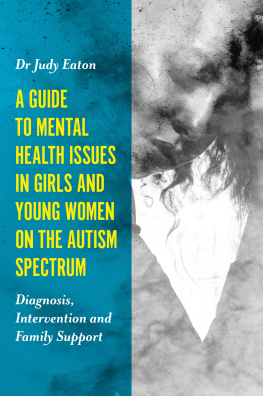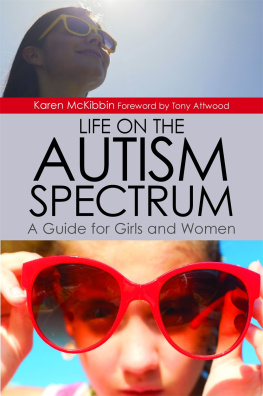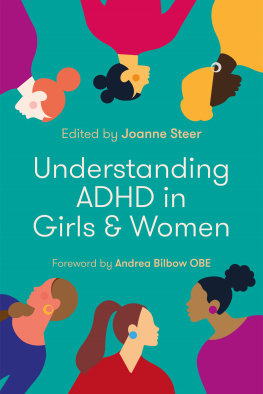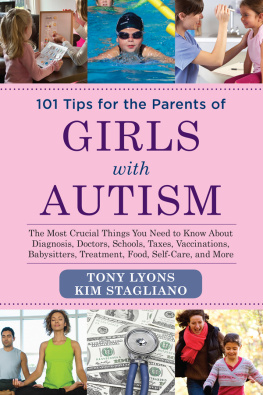
A GUIDE TO MENTAL HEALTH ISSUES IN GIRLS AND YOUNG WOMEN ON THE AUTISM SPECTRUM
Diagnosis, Intervention and Family Support
Dr Judy Eaton

Jessica Kingsley Publishers
London and Philadelphia
Contents
Preface
The motivation to write this book came about as a result of many years of working clinically with individuals who have autism, both in a diagnostic capacity and therapeutically.
Many girls and women did not (and still do not) get a diagnosis of their difficulties, and there is growing evidence that they will have an increased risk of experiencing issues with friendships and relationships, be prone to bullying and harassment, and may well experience significant mental health problems.
It is hoped that this book will further raise awareness of this important area and provide guidance for both families and those working professionally with this group.
List of Abbreviations
3Di Developmental, Dimensional and Diagnostic Interview
ABA applied behavioural analysis
ADHD attention deficit hyperactivity disorder
ADI-R Autism Diagnostic Interview Revised
ADOS Autism Diagnostic Observation Schedule
AQ autism-spectrum quotient
ARFID avoidant and restrictive food intake disorder
ASD autism spectrum disorder
BMI body mass index
BVAQ Bermond-Vorst Alexithymia Questionnaire
CAMHS Child and Adolescent Mental Health Services
CAT cognitive analytic therapy
CBT cognitive behavioural therapy
CDC Centers for Disease Control and Prevention
CGAS Childrens Global Assessment Scale
CRT cognitive remediation therapy
CTO community treatment order
DID dissociative identity disorder
DISCO Diagnostic Interview for Social and Communication Disorders
DBD disruptive behaviour disorders
DBT dialectical behavioural therapy
DDP dyadic developmental psychotherapy
DSM-5 Diagnostic and Statistical Manual of Mental Disorders, 5th Edition
ECT electroconvulsive therapy
EDA-Q Extreme Demand Avoidance Questionnaire
EQ empathy quotient
FII fabricated and induced illness
GP general practitioner
ICD-10 International Classification of Diseases and Related Health Problems, Version 10
IRI Interpersonal Reactivity Index
IU intolerance of uncertainty
MCDD multiple complex developmental disorder
NICE National Institute for Health and Care Excellence
NLD non-verbal learning disability
OCD obsessive compulsive disorder
ODD oppositional defiance disorder
PBS positive behaviour support
PDA pathological demand avoidance
PDD-NOS pervasive developmental disorder not otherwise specified
PTSD post-traumatic stress disorder
RBS-R Repetitive Behaviour Scale Revised
SCID-IV Structured Clinical Interview for DSM-IV Axis 1 Disorders
SQ systemising quotient
WISC-IV Wechsler Intelligence Scale for Children, Version IV
Chapter 1
Accessing a Diagnosis
This chapter explores the issues that face families trying to access a diagnosis from their local autism/neurodevelopmental team.
It also examines the NICE (National Institute for Health and Care Excellence) guidelines for assessment and diagnosis and the ICD-10 and DSM-5 criteria, and explores both autism and pathological demand avoidance in girls.
This chapter also looks at the types of assessment tools (including gold standard assessments such as the Autism Diagnostic Observation Schedule (ADOS)) commonly used in diagnosis and examines how these tools can often fail to identify the difficulties experienced by girls on the autism spectrum.
The idea for writing this book started when I began working in a newly opened Tier 4 CAMHS (Child and Adolescent Mental Health Services) inpatient unit in the United Kingdom, for adolescents between the ages of 12 and 18. The unit opened in 2013 and plans were in place, at that time, to expand the age range up to 25. This came about following the report by Austen (2009) which referred to the transition from child to adult mental health services as like falling off a cliff. Many of the patients admitted to the unit were female and it quickly became apparent that a high number of these young women either came into hospital with a diagnosis of autism or were subsequently assessed and given a diagnosis. Presenting difficulties ranged from eating disorders through to extreme self-harm and suicidal ideation. Most also presented with extremely challenging, and often violent, behaviour. A number were (wrongly) diagnosed as having emerging borderline personality disorder or schizo-affective disorder. Some seemed to meet diagnostic criteria for bipolar affective disorder. All were extremely troubled and distressed young women, who were often many miles away from family and friends and placed in an environment which, although every effort had been made to make the hospital as welcoming and friendly as possible, was often very noisy and brightly lit.
It was then decided to carry out an informal audit of all the patients admitted. This revealed that some 36 per cent of all of the girls admitted to the hospital were somewhere on the autism spectrum. Some, initially diagnosed with autism (usually atypical autism), quite clearly met the criteria for pathological demand avoidance (PDA). Pathological demand avoidance was first described by Elizabeth Newson in the 1980s and is now widely accepted as being part of the broader autism spectrum. However, very little research evidence is available regarding the behavioural outcomes of children diagnosed with pathological demand avoidance when they reach adolescence and beyond. Many professionals dislike the use of the term pathological when describing the degree of anxiety and demand avoidance, as they feel it is judgemental and derogatory to the young person. Others object to its use in diagnostic terms, because it does not appear in the current versions of the diagnostic manuals used in clinical practice. However, there is no doubt that there is a (albeit small) group of young people (both males and females) who present with a consistent pattern of extremely high levels of anxiety and rigid thinking, which leads to avoidance of everyday demands (such as dressing, going to school, holding down a job), including everyday boundaries and instructions. Some clinicians attribute this to trauma and early attachment difficulties, others to parenting issues, and there are currently no clear guidelines for supporting this group of young people, and little research about the impact of these difficulties over a persons lifetime.
Research evidence regarding the mental health issues experi-enced by young people on the autism spectrum (Skokausus and Gallagher 2012) noted that around 46.2 per cent are likely to suffer from significant anxiety. This is probably an under-estimation. Clinical experience of working with this client group would suggest that the percentage is likely to be much higher. Siegel et al. (2011) noted in a study of 33,000 children in the United States that young people with autism were 11.9 times more likely to need admission to a psychiatric hospital than typically developing children. A study by Ghaziuddin et al. (2002) suggested that 40 per cent of males with a diagnosis of autism show evidence of psychiatric co-morbidity (depression, anxiety, obsessive compulsive disorder (OCD), episodes of psychosis). It was also reported that the Lorna Wing Centre for Autism (which is one of a handful of centres across the United Kingdom that assess the more complex cases where autism is suspected) revealed that the co-morbidity of autism for psychiatric conditions in women was very high, with diagnoses of eating disorders, personality disorder and selective mutism being common.
Next page













